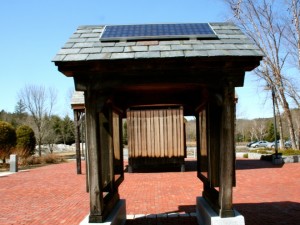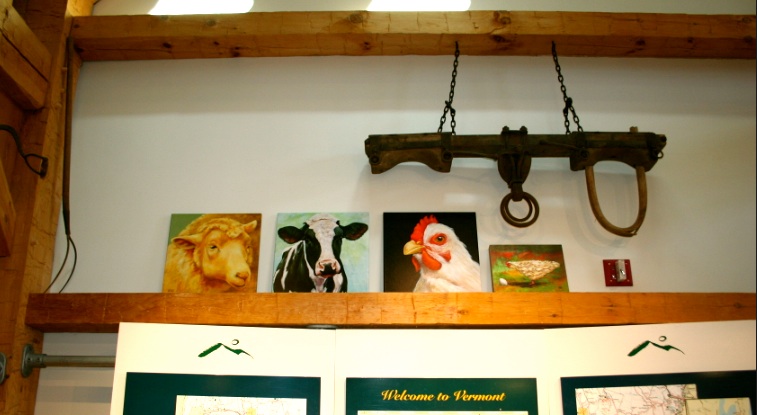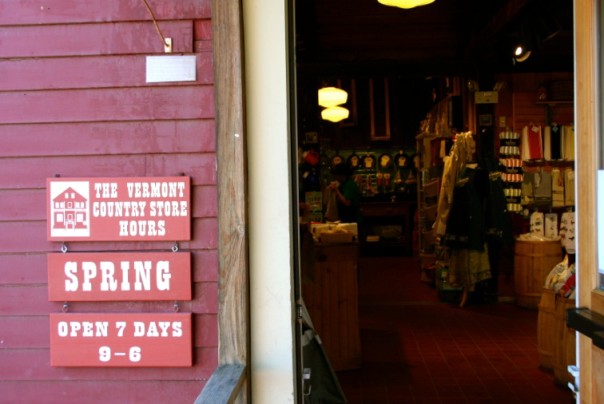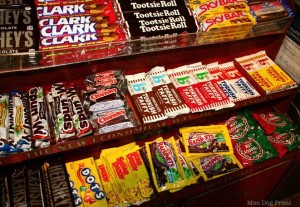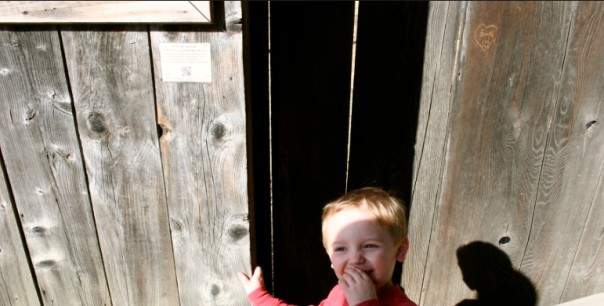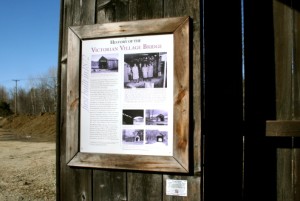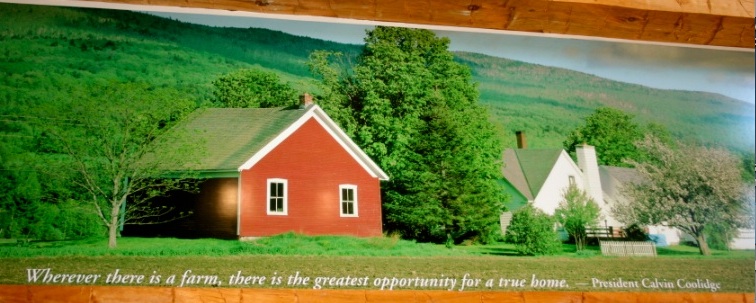Grist For The Mill, Covered Bridge, Ox Bows, Country Store and Neccos
Vermont has always been home to people who think for themselves. So it's not a surprise that farms of a different kind have sprouted up in the Green Mountain state. Solar arrays are not a new idea, but a more widespread adaptation of them certainly is. In Connecticut, paring down an electric bill in the past year means seeing the bottom line double anyways due to company “rate increases” – maybe in part for corporate re-branding. So the possibility of other options grows even more attractive with each bill.

Array at Harlow Farm by Soveren Solar, their mission is to help “build sustainable communities through the development of local renewable energy.”
At the Vermont Welcome Center in Guilford there is a panel atop an outdoor kiosk. But solar power is also sparking debate since they do change the look of the landscape, something Vermont residents and their leaders know draws visitors from far and near to their state. Those tourists are like the tide – they spend time and money and go back to where they call home. That's also an enviable part of local economies. How to balance all of the factors, well, that takes applied know-how and finesse to grow a community well.
Seeing a wooden yoke with only one bow (the U-shaped part) led to Building an Ox Yoke by David Kramer, Tillers International. A PDF lists schematics and a list of the best woods for processes. The amount of knowledge to craft this not-so-simple machine takes knowledge of the animals as they grow; tools, wood and their properties. Positioning the hardware takes another mathematical and analytic skill set. The way the bows are bent and seasoned is worth reading, as you will never look at a working team using this time-tested device the same again.
The Oxbow is also the name of a former bend in the Connecticut River, as seen in Northampton, Massachusetts. Similar to Wethersfield Cove, the more placid body of water is what results when the river changes course and a portion is cut off, left behind. Ideal for a marina, which takes its name for the place in which it is located.
The river also enriches the land beside it with seasonal floodings. There are fields and farms a-plenty seen from I-91 heading north. The road opens up; there and less people. Open fields dotted with stubble are framed by the Green Mountains that are more gray blue in spring. Climb in elevation and go back a tick in the seasonal progression of time.
Nostalgia is big business at the Vermont Country Store at Rockingham (one of two, this is the “new” store), where durable goods, useful things, Vermont old-fashioned common crackers, dips and fresh wheels of cheese (free samples) beckon for attention.
What's gets me to step up to the register is the Necco wafers, $1.50 for one roll of thin dusted-with-sugar discs of orange, lemon, lime, clove, chocolate, cinnamon, licorice, wintergreen stacked in a waxed paper wrap. Savored then crunched to dust, they didn't last long and sure tasted good.
There was time on the return drive to scrutinize the fine print on the covering – “made in the U.S.A. since 1847” and the address of the New England Confectionery Company, located in Revere, Mass. Each wafer bears the imprint of the company which makes it. The ingenuity of pharmacist Oliver R. Chase who invented a way to cut the sweet dough to make lozenges, and by so doing, created the first-ever candy-making machine is told by the Samira Kawash, Professor Emerita of Rutgers University in her book Candy: A Century of Panic and Pleasure.An inflatable Bozo the clown waits for a bop to be set into motion; there are bins full of marbles, parachute men to purchase then take home to toss into the air; Silly Putty in its iconic plastic egg, Fisher-Price toy cameras and a telephone with a dial and eyes that move; a wall of puzzles – and that's just one corner of the toy section. Never made it to the second floor loft. There was time for looking over the colorful display of candies by the front door – and it was a relief to get outdoors again.
“Fasten seatbelt, someone needs you” – a black-and-white sign that stands near the grist mill and water wheel museum parking area.
Out on the front lawn are toys and a porch swing. Cross the covered bridge to see the grist mill, wooden sluiceway and millpond. Not yet in operation for the season, it's still fun to walk and peer inside. A mat on the porch of the mill activates a light inside, so it is possible to see the millstones and a small model of how the whole thing works to grind grains into flour or other products. The covered bridge is real (dismantled from its original location and rebuilt here), but to walk over the weathered boards underfoot trip-trop-trip-trop is a good way to burn some energy and investigate how the structure is built. It's neat and accessible.Part of the crew takes a walk and returns for a tailgate picnic. Yes, there is still snow lingering on the grounds, but the April sunshine is warm. A man stops by to share some stories about the mill and suggests we return in a few weeks to see it in operation as the sluiceway channels water from up the hill. He has left by the time I walk around the mill, peer in the window and look over the water wheel. I'd like to know more.
Poking around in the virtual universe, there is a listing of old mills complied by Ohiobarns.com. For the true enthusiast, the Society for Industrial Archaeology (SIA) has members world-wide with an interest in “preserving, interpreting and documenting our industrial past and heritage.” There's a lot to learn about how people solved problems with machines and changed the way humans work.
“Wherever there is a farm, there is the greatest opportunity for a true home” – President Calvin Coolidge
The historic President Calvin Coolidge home in Plymouth Notch, Vermont, is a gem of a place with a simple farmhouse and preserved outbuildings that include a tool room, barn, buttery, woodshed, laundry, privy. But this paragraph excerpt from the state's historic sites says plenty about the resourceful character of people who lived here:
“Colonel John was a remarkable example of ‘the versatile Vermonter.' He was, at one time or other, a selectman, tax collector, road commissioner, school teacher, school superintendent, deputy sheriff, town constable, Justice of the Peace, Representative in the Vermont Legislature, State Senator, notary public, an insurance agent for Dun and Bradstreet, Colonel on Governor Stickney’s staff, and a sergeant in the Vermont National Guard. He was also a brick and stone mason, carriage maker, wheelwright, harness maker, undertaker, coffin maker, carpenter, tinsmith, plumber, blacksmith, bookkeeper, woodsman, cattle doctor, water dowser, farmer, mechanic, and storekeeper.
Calvin Coolidge wrote about his father in his autobiography: “… my father was very skillful with his hands… He had a complete set of tools, ample to do all kinds of building and carpenter work… . The lines he laid out were true and straight, and the curves regular. The work he did endured. If there were any physical requirements of country life which he could not perform, I do not know what it was.”
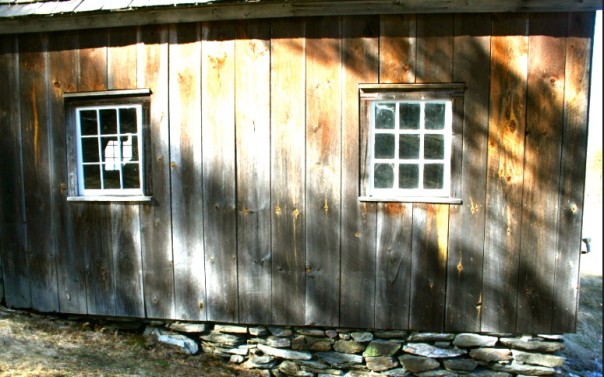
To take a virtual tour of the President Calvin Coolidge Homestead, visit this link to the official site.
Note: The grist mill waterwheel at the Vermont Country Store in Rockingham is there year-round, but to be sure and see it in operation when the water is flowing, call ahead; (800) 547-7849.

